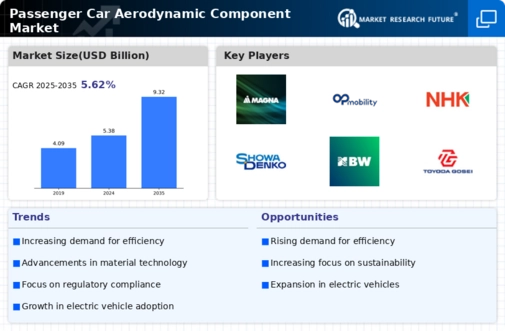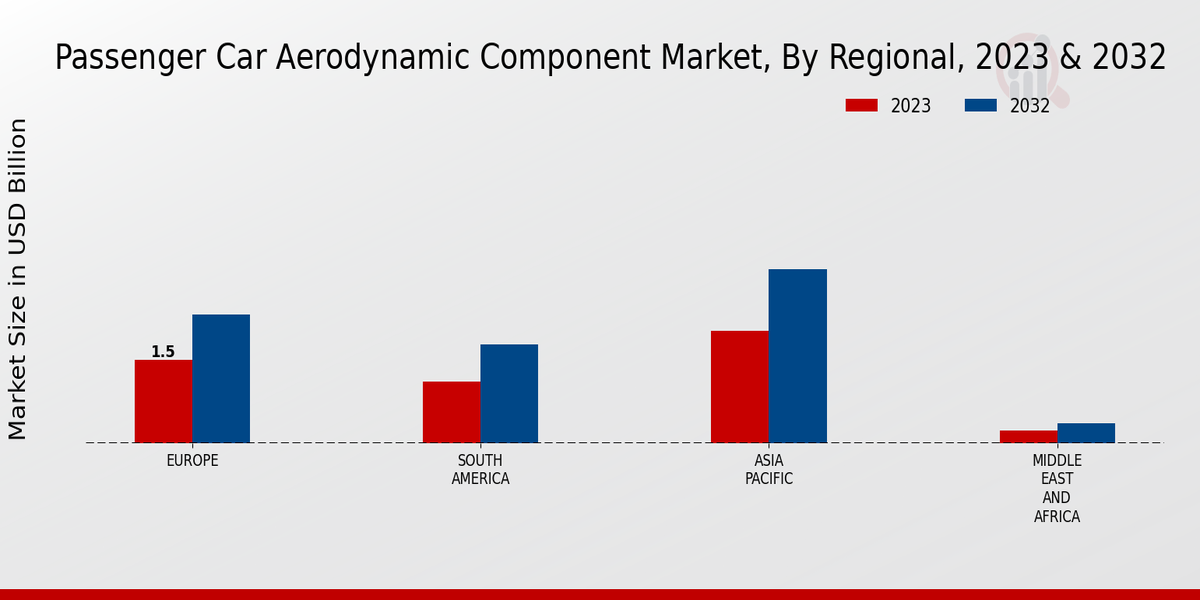Market Growth Projections
The Global Passenger Car Aerodynamic Component Market Industry is poised for substantial growth, with projections indicating a market value of 5.38 USD Billion in 2024 and an anticipated increase to 9.32 USD Billion by 2035. This growth trajectory reflects a compound annual growth rate of 5.12% from 2025 to 2035, driven by various factors including technological advancements, regulatory pressures, and shifting consumer preferences. The market's expansion is indicative of the increasing importance of aerodynamic components in enhancing vehicle efficiency and performance. As manufacturers continue to innovate and adapt to market demands, the industry is likely to witness significant developments in aerodynamic technologies and designs.
Rising Demand for Fuel Efficiency
The Global Passenger Car Aerodynamic Component Market Industry experiences a notable surge in demand for fuel-efficient vehicles. As consumers increasingly prioritize sustainability, automakers are compelled to enhance vehicle designs to reduce drag and improve fuel economy. This trend is evidenced by the projected market value of 5.38 USD Billion in 2024, reflecting a growing emphasis on aerodynamic components that contribute to lower fuel consumption. Enhanced aerodynamics not only meets regulatory standards but also appeals to environmentally conscious consumers, thereby driving innovation in design and materials. Consequently, manufacturers are investing in advanced aerodynamic technologies to remain competitive in this evolving landscape.
Consumer Awareness and Preferences
Consumer awareness regarding the environmental impact of vehicles is reshaping the Global Passenger Car Aerodynamic Component Market Industry. As buyers become more informed about fuel efficiency and emissions, they increasingly favor vehicles equipped with advanced aerodynamic features. This shift in consumer preferences is prompting manufacturers to prioritize the development of aerodynamic components that enhance vehicle performance while minimizing environmental impact. The growing demand for such vehicles is likely to contribute to the market's expansion, as evidenced by the projected growth trajectory leading to a market value of 9.32 USD Billion by 2035. This trend highlights the necessity for manufacturers to align their product offerings with consumer expectations for sustainability.
Growth of Electric and Hybrid Vehicles
The rise of electric and hybrid vehicles is a transformative factor in the Global Passenger Car Aerodynamic Component Market Industry. These vehicles often require specialized aerodynamic designs to optimize range and efficiency. As the market for electric and hybrid vehicles expands, manufacturers are increasingly focusing on aerodynamic components that enhance performance and energy efficiency. This trend is further supported by the anticipated market growth, with projections indicating a value of 5.38 USD Billion in 2024. The integration of aerodynamic innovations in electric and hybrid vehicles not only improves their marketability but also aligns with the global shift towards sustainable transportation solutions.
Technological Advancements in Aerodynamics
Technological advancements play a pivotal role in shaping the Global Passenger Car Aerodynamic Component Market Industry. Innovations in computational fluid dynamics and wind tunnel testing have enabled manufacturers to design more efficient aerodynamic components. These technologies allow for precise simulations and testing, leading to improved vehicle performance and reduced drag coefficients. As a result, the industry anticipates a compound annual growth rate of 5.12% from 2025 to 2035, driven by the continuous evolution of aerodynamic technologies. This growth is indicative of the industry's commitment to integrating cutting-edge solutions that enhance vehicle efficiency and performance, thereby attracting a broader consumer base.
Regulatory Pressure for Emission Reductions
The Global Passenger Car Aerodynamic Component Market Industry is significantly influenced by regulatory pressures aimed at reducing vehicle emissions. Governments worldwide are implementing stringent emission standards, compelling manufacturers to adopt aerodynamic enhancements that lower carbon footprints. For instance, the European Union's regulations on CO2 emissions have prompted automakers to invest in aerodynamic components that contribute to compliance. This regulatory landscape not only drives innovation but also fosters collaboration between manufacturers and regulatory bodies. As the industry adapts to these evolving standards, the market is expected to grow, with projections indicating a value of 9.32 USD Billion by 2035, underscoring the importance of aerodynamic efficiency in meeting regulatory requirements.



















Leave a Comment